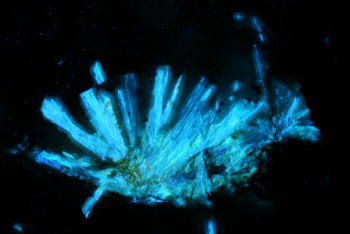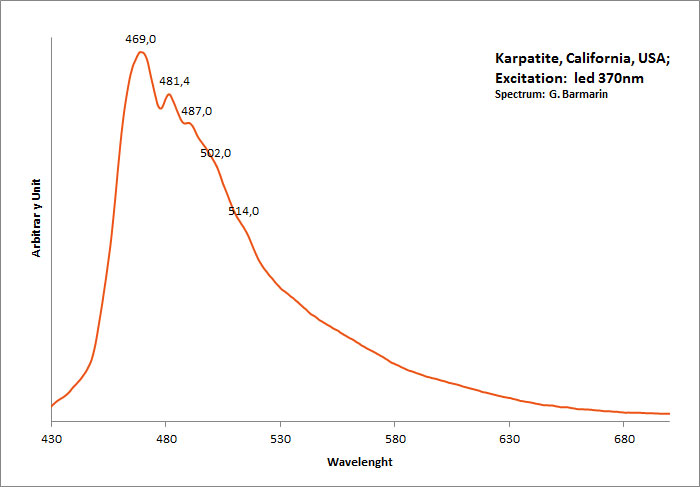Database of luminescent minerals
CARPATHITE
Chemical formula: C24H12
Family: Organic
Status: IMA-GP
Display mineral: OUI
Associated names (luminescent varieties, discredited names, synonyms, etc.): karpatite, pendletonite,
Luminescence:
Longwave UV (365nm) colors: |
Bluish White , | ||
Intensity LW:Strong | Frequency LW:Always | ||
Shortwave UV (254nm) colors: |
Bluish White , | ||
Intensity SW:Strong | Frequency SW:Always | ||
Daylight picture

carpathite (KARPATITE)
Picacho Mine, New Idria District, San Benito Co., California, USA;
Col. G.Barmarin; Photo: G. Barmarin
Shortwave (254nm) picture

carpathite (KARPATITE), UVSW
Picacho Mine, New Idria District, San Benito Co., California, USA;
Col. G.Barmarin; Photo: G. Barmarin
Pictures Galery:


 ...
...Do you have a photo of this mineral you would like to see in the gallery? Contact us!
Phosphorescence (in the common sense of the term) observable with the naked eye:
No data
Comments:
Chemically identical to Coronene (Hexabenzobenzene), a polycyclic aromatic hydrocarbon used to produce Organic Electroluminescent Material. The name replaces pendletonite (CNMMN, 1971), karpatite and coronene. Karpathite is composed of flakes of pure coronene embedded in sedimentary rock. This mineral may result from ancient hydrothermal vent activity. See gallery for a scheme of the chemical structure of coronene. Beware when manipulating, coronene is toxic and carcinogen:
Activator(s) and spectrum:
Activator(s): Matière organique intrinsèque,
Peaks in the spectrum (nm):
462nm, (482), (493), (503), (515)

KARPATITE, Picacho Mine, California, USA. Excitation: laser 405nm. Col. G. Barmarin; Spectre: G. Barmarin
Spectrum Galery:
 ...
...Comments on spectrum and activators:
Blue luminescence due to the two linearly annelated benzene rings characteristic of aromatic compound (singlet-singlet electron transition within the benzene rings). Spectral lines (cm-1): 208, 192, 178, 164.
Best localities for fluorescence (*):
- Picacho Mine, Picacho Peak, New Idria District, Diablo Range, San Benito Co., California, USA ;
- 4th of July Mine, Flint group, Hernandez, Clear Creek area, Picacho Peak, New Idria District, Diablo Range, San Benito Co., California, USA ;
- Alpine Mine, Picacho Peak, New Idria District, Diablo Range, San Benito Co., California, USA ;
- Tamvatnei Hg deposit, Tamvatnei massif, Koryakskoe plateau, Chukotskii Autonomous Okrug, Far-Eastern Region, Russia ;
- Olenevo, Svalyavskyi Raion, Zakarpats'ka Oblast', Ukraine ;
(*)The data are not exhaustive and are limited to a few remarkable localities for fluorescence
Bibliographic reference for luminescence:
- The Henkel Glossary of Fluorescent Minerals, Dr. Gerhard Henkel, Published by the FMS, 1989 ,
- Fluorescence: Gems and Minerals Under Ultraviolet Light, Manuel Robbins, 1994, Geoscience Press, ISBN 0-945005-13-X ,
- The World of Fluorescent Minerals, Stuart Schneider, Schiffer Publishing, 2006, ISBN 0-7643-2544-2 ,
- Luminescent Spectra of Minerals, Boris S. Gorobets and Alexandre A. Rogojine, Moscow, 2002 ,
Reference for luminescence on the Internet:
Images:
- Olenevo, Ukraine: http://www.mindat.org/photo-691255.html
- Picacho Mine, Ca, USA: http://www.mindat.org/photo-554727.html
- Picacho Mine, Ca, USA: http://www.mindat.org/photo-421057.html
- Picacho Mine, Ca, USA: http://www.mindat.org/photo-376686.html
- Picacho Mine, Ca, USA: http://www.mindat.org/photo-345837.html
- Alpine Mine, Ca, USA: http://www.mindat.org/photo-175001.html
Mineralogical reference on the Internet:
 http://www.mindat.org/show.php?name=Carpathite
http://www.mindat.org/show.php?name=Carpathite
 http://webmineral.com/data/Carpathite.shtml
http://webmineral.com/data/Carpathite.shtml
Internet Search:
 Image search on 'Google Images'
Image search on 'Google Images'
 Search for documents in all languages on Google
Search for documents in all languages on Google
A request providing no result means only that no such reference exists in the database, but it does not mean that what you are looking for does not exist, just not to our knowledge. If you think you have found an error or omission, please let us know via the contact page being sure to cite the source of information.

